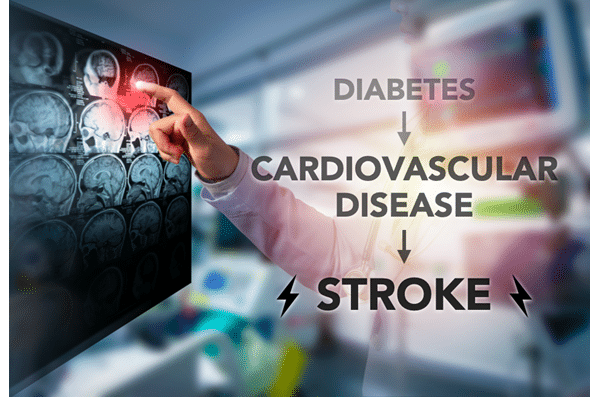Home » Health Education » Diabetes » Diabetes, Cardiovascular Disease and Stroke

Diabetes, Cardiovascular Disease and Stroke
It’s estimated that 1 in 10 Americans has diabetes. Cardiovascular disease is one of the top killers in the U.S., especially among men. Almost 800,000 Americans suffer from a stroke each year. The human body is an interconnected machine, so it should come as no surprise that these three are linked. But how? Read on to see how elevated blood sugar can ultimately lead to a fatal stroke.
What is diabetes?
Diabetes is defined as having too much glucose (or blood sugar) in the blood. When your body has more glucose in its system than it can handle, there are a number of negative effects. There are three kinds of diabetes:
Type 1 Diabetes – Most people with type 1 diabetes were born with it. Their bodies can’t produce insulin or have a resistance to it. Insulin is what transports glucose throughout the body. These people make up roughly 5% of all diabetes cases.
Prediabetes – A person is said to have prediabetes when their blood sugar level is elevated, but not high enough to qualify for a full diabetes diagnosis. Prediabetes is preventable and reversible with the right diet and lifestyle changes.
Type 2 Diabetes – This is diabetes that is developed later in life and is usually due to a combination of poor diet, lack of exercise and obesity, but there are other factors as well.
How diabetes leads to cardiovascular disease
When you have too much glucose in your blood, it damages blood vessels. The most important blood vessels in the body are the ones that make up the heart and major arteries. When the blood vessels get damaged enough, it inhibits the heart’s ability to get blood throughout the body, resulting in cardiovascular disease.
Insulin resistance has also been tied to obesity. When the body is unable to properly transport glucose, you feel hungry even if you are full. This can cause people to overeat. Also, diets that are high in sugar elevate glucose levels further while offering little nutritional value. This leads to an increased likelihood of weight gain and, eventually, obesity.
Obesity increases a person’s risk for cardiovascular disease because it puts extra pressure on the blood vessels, constricting blood flow. This causes blood pressure to go up and puts additional strain on the heart.
Diabetes also affects the natural balance of cholesterol in the body. Those with diabetes have been shown to have an abnormally high number of low-density lipoproteins (LDLs), or “bad” cholesterol, which deposit plaque into artery walls. They also have an abnormally low number of high-density lipoproteins. These are often called “good cholesterol” because they remove cholesterol buildup from artery walls and allow blood to flow more freely.
How does cardiovascular disease increase the risk of a stroke?
A stroke occurs when a blood clot gets lodged in a blood vessel carrying blood to the brain. When the blood is deprived of oxygen, the effects can be seen almost immediately. Some signs of a stroke can depend on whether it occurs on the left or right side of the brain, but there are universal warning signs as well. include:
- Face drooping on one side
- Weakness in the arms
- Difficulty speaking
- Confusion
Those with cardiovascular disease have damaged blood vessels throughout the body — including vital ones like the aorta. These blood vessels are often constricted and damaged due to plaque buildup and have exterior pressure due to obesity. In some cases, the vessels have been damaged in such a way that the inside of the blood vessels is rough, which makes it even more difficult for blood to pass through.
Combine all of these factors together and the risk of someone having a blood clot goes up significantly. Blood clots can occur anywhere and, if they are small enough, can travel throughout the body. However, if they grow too large or find their way to a blood vessel that is too small for them to pass through, the person will suffer an immediate medical emergency.
Concerned about your risk for diabetes and cardiovascular disease?
Life Line Screening offers tests that assess your risk for both of these dangerous conditions.
The diabetes test is a quick and easy finger prick that can measure the amount of glucose in the body. This gives the technician a number they can use to show the risk for prediabetes and type 2 diabetes, which can then be shared with a doctor.
To assess risk for cardiovascular disease, patients undergo a painless and non-invasive ultrasound. The ultrasound is able to scan the arteries throughout the body to see how well they are transporting blood and their overall health. Any early warning signs of cardiovascular disease can often be caught here before they progress into a more serious condition.
If you’d like to take control of your health and receive this vital health information, click below to find a Life Line Screening near you.
Sources
Statistics About Diabetes | American Diabetes Association
Cardiovascular Disease and Diabetes – Heart.org
Learn more or schedule a screening today at lifelinescreening.com — or give us a call at 888.852.8378. We’d love to help.
Topics:
Diabetes
